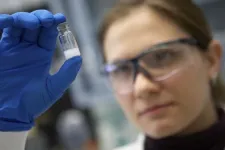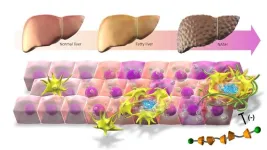(Press-News.org)
Transition metals form catalytic complexes that can speed up various chemical processes, especially in the production of pharmaceuticals as well as various pigments, dyes, and laboratory reagents like sulfuric acid. The use of light emitting diodes (LEDs) has boosted the use of visible light in reaction catalysis, and scientists have developed photo-redox catalysts made of iridium and ruthenium, which facilitate catalysis when irradiated with specific wavelengths of light. Further, scientists have even demonstrated visible light photoreactions with palladium complexes without the use of photo-redox catalysts. While several such transition metal-catalyzed photoreactions have been developed, there has been limited development of new ligands for these reactions; most studies used existing ligands that were developed for thermal reactions. Thus, there has been a notable lack of development of ligands that interact specifically with transition metal catalysts in photoreactions, preventing us from unlocking the true potential of such reactions.
Recently, a team of researchers, led by Professor Tetsuhiro Nemoto from the Graduate School of Pharmaceutical Sciences at Chiba University in Japan, developed novel ligands that can be used in photoreactions with transition metal catalysts. They also demonstrated how the developed ligands interacted with different transition metals to produce different catalytic results for photoreactions.
The team included Mr. Yu Matsuda from the Graduate School of Pharmaceutical Sciences at Chiba University and Dr. Masaya Nakajima, who was affiliated with the same institute at the time of the study but is now affiliated to the Graduate School of Pharmaceutical Sciences at the University of Tokyo. Their work was made available online on July 20, 2023, and was published in Volume 13, Issue 15 of ACS Catalysis on August 4, 2023.
The researchers utilized commercially available 9-phenylacridine to prepare four acridine-containing PNP-pincer ligands, which were then used to create complexes with nickel, palladium, platinum, copper, and cobalt.
The team evaluated the catalytic activity of the complexes for a specific photoreaction called transfer hydrogenation, a common reaction used in various industries. While the nickel complex did not react efficiently, the palladium and platinum complexes successfully catalyzed the reaction to provide a high yield of the final products.
Specifically, the researchers found that the newly developed ligands allowed the platinum complex to successfully catalyze a reaction in the presence of visible light (blue LED irradiation) in a stoichiometric manner. This means that the exact values of reagents needed, and the quantity of product obtained, can be mathematically calculated. The preciseness of the catalysis will allow the streamlining of industrial processes, such as in the production of medicines. Furthermore, the new platinum complex could catalyze the hydroxy/alkoxy alkylation of olefins—a reaction that could not be catalyzed with existing well-known ligands.
The fact that these photoreactions did not occur in the presence of well-known ligands highlights how the newly designed ligands could help define new reaction capabilities. Explaining the results, Dr. Nakajima says, “This research reveals a new reactivity of platinum that was previously unknown. As a result, it has become possible to synthesize new kinds of molecules more efficiently, potentially finding applications in the manufacturing of novel materials and pharmaceuticals.”
The present study is also expected to have numerous long-term implications. “Visible light is utilized as the energy source for such reactions. Thus, sunlight can be used as an endless source of energy, and technological advancement could allow us to perform photoreactions without the constraints that come with the arrangements necessary for thermal reactions, ultimately helping us resolve emerging energy issues,” concludes Dr. Nakajima on an optimistic note.
Indeed, the development of new ligands for transition metal complex photocatalysis can create new possibilities and redefine reaction capabilities, allowing novel solutions to the challenges we face today.
About Professor Tetsuhiro Nemoto
Dr. Tetsuhiro Nemoto is a Professor at the Graduate School of Pharmaceutical Sciences at Chiba University. His research focuses on the development of innovative methodologies and catalytic reactions in the field of synthetic organic chemistry. He utilizes computational chemistry techniques to design functional molecules and unravel the mechanisms of chemical reactions. He has published around 135 research papers with over 3,500 citations. His goal is to develop organic molecules that can be applied in medicinal chemistry research.
END
Physical health and cognitive function declines as we age. Aging impacts people’s ability to perform routine tasks, which affects their well-being and sense of independence. One such routine activity that is frequently affected is driving. For older adults, the inability to drive themselves can mean that they become unable to access basic needs or engage in social activities.
In a recent study that was made available online on 29 August 2023 and is all set to be published in volume 176 of Transportation Research in October 2023, researchers ...
WASHINGTON—Pediatric endocrinologists are concerned for their safety and their ability to provide evidenced-based care to transgender and gender-diverse adolescents amid political divides over gender-affirming care, according to a new paper published in the Journal of the Endocrine Society.
Pediatric endocrinologists specialize in the care of children and adolescents with disorders related to hormones and the glands that produce them, such as diabetes and disorders of growth, thyroid or puberty. Some pediatric endocrinologists also provide gender-affirming care as part of their medical practice.
Among youth ages 13 to 17 in the United States, 1.4% identify as transgender, ...
Scientists are looking to plant tissues that are capable of motion to inspire the design and fabrication of artificial actuators. These bioinspired actuators hold significant potential in applications, such as soft robotics, prosthetics, and smart biomedical devices. A research team from the Chinese Academy of Sciences has published a perspective paper focusing specifically on the ways plants regulate their motion speed and how this might be applied with artificial actuators.
Their paper is published in the journal Nano Research on September 18.
These artificial actuators, that are responsive to humidity, solvents, heat, light, and electricity, ...
A research group from the Graduate School of Medicine and Research Institute of Environmental Medicine at Nagoya University reported that cholesterol accumulation in macrophages promotes liver fibrosis in the development of non-alcoholic steatohepatitis (NASH). Using a unique supramolecule, they removed cholesterol in a mouse model, stopping the development of the disease. As cholesterol crystals are also found in human patients, this suggests a potential treatment for the disease. Their findings were published in the Journal of Experimental Medicine.
As the number of patients with ...
The rapid advancements in flexible electronic technology have led to the emergence of innovative devices such as foldable displays, wearables, e-skin, and medical devices. These breakthroughs have created a growing demand for flexible adhesives that can quickly recover their shape while effectively connecting various components in these devices. However, conventional pressure-sensitive adhesives (PSAs) often face challenges in achieving a balance between recovery capabilities and adhesive strength. In an extraordinary study conducted at UNIST, researchers have successfully synthesized new types of urethane-based crosslinkers that address this critical challenge.
Led by Professor Dong Woog ...
The Resilience Justice Project (RJ Project) at the University of Louisville’s Brandeis School of Law has been awarded a one-year multi-institutional grant through a national competitive process to evaluate how climate adaptation planning can be more equitable for low-income communities in eight U.S. coastal areas.
The RJ Project will use the $75,000 award from the National Sea Grant Law Center through NOAA’s National Coastal Resilience Fund to examine coastal urban adaptation in the eight cities: Boston, Cleveland, Miami, New Orleans, San Diego, Savannah, Seattle and Tampa. Principal ...
Technological progress can reduce the energy required to achieve the same ends, reducing the use of fossil fuels and the greenhouse gases associated with burning fossil fuels. But technological progress can also make production, consumption, and travel cheaper, stimulating demand and consequently increasing greenhouse gas emissions. Sai Liang and colleagues sought to explore this conundrum by building an environmentally extended general equilibrium model with heterogeneous agent and input-output network covering 141 nations and 65 sectors, ...
COLUMBUS, Ohio – It turns out yogurt may have a previously unknown benefit: eliminating garlic odors.
A new study conducted in a lab – with follow-up human breath tests being planned – showed that whole milk plain yogurt prevented almost all of the volatile compounds responsible for garlic’s pungent scent from escaping into the air.
Researchers tested the garlic deodorizing capacity of yogurt and its individual components of water, fat and protein to see how each stood up to the stink. Both fat and protein were effective at trapping garlic odors, leading the scientists to suggest high-protein ...
Researchers led by Yuko Motizuki from the Astro-Glaciology Laboratory at the RIKEN Nishina Center in Japan have developed a new laser-based sampling system for studying the composition of ice cores taken from glaciers. The new system has a 3-mm depth-resolution—about 3 times smaller than what is currently available—meaning that it can detect temperature variations that occurred over much smaller periods of time in the past. The new laser melting sampler, or LMS, is expected to help reconstruct continuous annual temperature changes that occurred thousands to hundreds of thousands of years ago, which will ...
PULLMAN, Wash. -- Scientists have found a plant gene that drives the growth of root hairs, the tiny structures that help plants find water and nutrients in the soil.
Identified by a team led by Washington State University researcher Karen Sanguinet, the gene, dubbed “BUZZ,” causes faster-growing, denser webs of roots and may also determine how plants find and use nitrates, a prime source of nitrogen essential to plant growth. Nitrates are also used in fertilizers that can pollute the environment as runoff, and this genetic discovery could ultimately help plant scientists find ways to grow crops more sustainably.
“Nitrate ...









